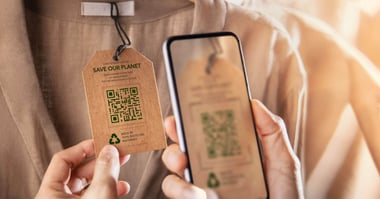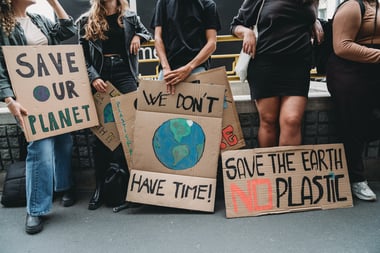
Tamara Davison
Tamara Davison is a journalist who specializes in sustainability and the environment. Reporting from around the world, she's seen firsthand the direct impact waste is having on coastal communities and our oceans. As a diver trained in ecological monitoring, the changes Tamara has seen in marine habitats inspired her to action. She's previously written for The Guardian, The Independent and the Evening Standard. She's also produced environmental documentaries for EuroNews.
Greenwashing — where companies deceptively inflate their environmental credentials — is no longer just a buzzword. It’s a rising trend, and many business leaders know they’re doing it.
With 88% of Gen-Z shoppers now distrusting brands’ environmental, social, and governance (ESG) claims, according to McKinsey, it’s clear the approach to greenwashing has shifted. Many consumers would even boycott businesses that fail to act on climate change.
To appeal to future consumers, companies must take a hard line on greenwashing — and here’s how you can do that.
What’s on this page?
01 | How to avoid greenwashing in your business
02 | Is corporate greenwashing on the rise?
03 | Are there any greenwashing laws in place?
04 | Examples of greenwashing cases
05 | Summary
06 | FAQs
How to avoid greenwashing in your business
Here are the top nine ways you can make sure to avoid greenwashing in your business.- Avoid vague language – Vague statements like ‘eco-friendly’ or ‘green’ don’t offer value to consumers or help you explain sustainability practices
- Be honest with your audience – Be open with customers if you’re still working on environmental goals. Consumers are less forgiving if they think a brand is deceiving them
- Set realistic targets – Focus on achievable targets you can monitor and report to avoid underdelivering on ambitious initiatives
- Partner with transparent businesses – Businesses like CleanHub can help you avoid greenwashing. We enable brands to reduce their plastic footprint while supporting coastal communities worldwide
- Get third-party verification – Qualifying for sustainable certifications can help build trust among consumers
- Audit supply chains – Supply chains tend to release the most emissions, so an audit ensures your environmental claims can be verified
- Support marketing with evidence – Support your messaging with statistics and facts that help consumers see the broader impact
- Share regular reports – To ensure accountability, share reports with your consumers, stakeholders, as well as regulators
- Educate customers and staff – Get your entire team on the same page by educating them about the signs of greenwashing and incentivizing sustainable practices
Let's take a deeper look into each section further below.
1. Avoid using vague language
A European Commission study found that 53% of green claims were “vague, misleading or unfounded.” Vague language can include phrases that can be easily misinterpreted, like ‘green’ or ‘planet friendly.’
Whether intentional or not, vague marketing language might signify greenwashing, and it’s a reason that some companies have been called out in the past.
H&M, for instance, was sued in 2022 for leading customers to believe their ‘conscious’ line of clothing was more environmentally responsible. The lawsuit alleged that the brand’s claims violated consumer protection laws as most garments were still manufactured from polyester or recycled plastic, which is bad for the environment.
To avoid coming under fire for vague language, ensure wording is specific and focuses on the actual impact. Provide clear statements that link to measurable goals, such as reducing emissions by a certain percentage or switching certain packaging to a more sustainable alternative.
2. Be honest with your audience
At least 94% of customers said they would be loyal to transparent brands, suggesting it’s in your interest to be authentic about environmental commitments. Loyal customers are also more likely to recommend your brand to others, helping you gain more recognition.
Even if your business hasn’t achieved its ESG goals, being open about progress is critical to counter greenwashing in 2024. Story MFG is an example of a brand doing this right; the fashion brand told its customers: “We do our best, but we are not perfect,” and goes as far as listing their environmental shortcomings to raise awareness of how far we’re yet to go.
3. Partner with transparent organizations
You can avoid greenwashing by partnering with companies that can help you achieve environmental goals. Certain businesses and technology can support tracking and reporting initiatives, enhance sustainability efforts, and oversee supply chains.
CleanHub is an example of an organization that can help you avoid greenwashing. Our plastic offsetting programs help businesses collect ocean-bound waste, ensuring they have a tangible environmental impact backed by proof.
But we’re not alone. Businesses can monitor carbon emissions with Watershed, support the health of our oceans with Sea Trees, or fund global environmental missions with 1% For The Planet, to name a few.
Want to reduce your business’s plastic footprint? We can help. Contact our in-house team to discuss which plastic recovery plan best suits your business needs.
4. Set realistic goals
Roughly 60% of businesses now have at least some sustainability initiatives in place. However, it’s essential to get these targets right.
Setting realistic goals means you can better track progress and celebrate milestones. This includes being realistic about the time frame needed to achieve specific tasks and preparing for when things might not quite go to plan.
As well as helping your business look good to consumers, setting realistic goals can also help incentivize your staff. A third of millennials have admitted they’d give more time and effort to a job based on their employer’s sustainability agenda.
5. Educate your customers, employees, and stakeholders
Education is a critical tool for combatting greenwashing, as it can empower consumers, business leaders, and stakeholders. Discussing the negative impacts of greenwashing internally and externally can help empower a new wave of environmental support.
McKinsey found that around 60% of people would favor products in sustainable packaging. However, other reports have revealed that most Americans can’t name a sustainable brand.
This suggests that there are gaps in the conscious consumer mindset — a perfect chance for businesses to lead in sharing environmental knowledge. It’s also where clear and transparent messaging is critical, as you can build brand awareness while empowering consumers to shop more sustainably.
Internally, training your team about greenwashing can go a long way. It can promote team accountability and help drive further innovation to improve broader sustainable initiatives.
6. Get third-party verification
To help build consumer trust and reduce allegations of greenwashing, consider third-party verification from organizations like B-corp, FSC, and TÜV SÜD. These are a few examples of official regulated bodies that verify your efforts based on established frameworks.
Around 6,000 businesses are B-Corp certified, meaning they’ve met the B Corporations's high environmental accountability standards. A further 50,000 businesses are FSC certified, meaning their practices align with efforts to protect forests as established by the Forest Council Stewardship.
Achieving these certifications means you’ve ticked certain boxes, which helps to validate any environmental claims. This can boost customer support, proving your entire business model is geared toward genuine ecological support.
7. Support marketing claims with evidence
A recent survey revealed that 71% of consumers don’t believe the environmental claims they see are verified or checked by independent regulators. On top of this, three-quarters of business leaders are skeptical that the ESG reporting of competitors and peers is legitimate.
Backing up claims with evidence is important to countering growing distrust regarding sustainability. This also circles back to our point about avoiding vague language, which should always be backed up with evidence if possible.
Leveraging technology is one way to achieve this. For instance, you can use QR codes on labels to show consumers testimonials from farmers involved in product manufacturing. This validates your sustainability efforts and helps customers feel directly engaged with the source of your environmental impact.
8. Audit supply chains
Experts believe around 70% of a company’s emissions come from its supply chain. However, Scope 3 emissions aren’t directly produced by the company, making them harder to monitor. This means being transparent and avoiding greenwashing is even more challenging.
Businesses should audit their supply chain regularly and optimize operations with sustainability in mind. This requires careful assessments of environmental impacts at each stage, meaning you’ll need to implement benchmarks and streamline reporting strategies.
You can usually seek third-party reporting tools to help you identify where processes can be improved in your supply chain. However, you’ll also need to ensure suppliers are on board to achieve this.
9. Regularly report your environmental achievements
Reporting on sustainability helps validate environmental claims further and gives you a competitive edge.
In 2022, the Carbon Disclosure Project (CDP) listed 272 companies, including L’Oreal and Unilever, on their A-List for environmental efforts. Companies had to disclose their carbon data through reporting to get on the list, helping to enhance their reputation among consumers and stakeholders.
The CDP highlighted that companies that reported environmental data gained multiple benefits. These businesses could “improve their reputation, get ahead of regulation, boost their competitive advantage, uncover risks and opportunities, track and benchmark progress, and get access to lower costs of capital.”

Is corporate greenwashing on the rise?
Businesses will likely ramp up efforts to support sustainability in line with consumer demand in the coming years. Unfortunately, this coincides with more greenwashing.
One report claimed there had been a 70% jump in greenwashing incidents in the financial sector last year alone. This trend isn’t unique either: a rise in greenwashing practices is reportedly happening in fashion and the food sector.
The lack of unified regulation related to greenwashing and poor oversight of environmental practices exacerbate the issue.
What’s more, the implications of this are wide-reaching. 2023 was the warmest year on record and a peak year for fossil fuel emissions, suggesting environmental progress has been slow.
Greenwashing has also led to nuanced impacts like the emergence of ‘greenhushing,’ where companies omit environmental data to dodge public scrutiny. This will make spotting greenwashing even more challenging, suggesting we face an uphill battle against the practice.
Are there any greenwashing laws in place?
Consumers are increasingly leveraging their purchasing power to back sustainable businesses. At the same time, local and national authorities are slowly implementing greenwashing laws to stop companies from cutting corners.
One of the latest examples was the EU’s Green Claims Directive, which aims to end misleading labels and unclear claims. While this should help consumers make more sustainable choices, it won’t be implemented until mid-2024.
In the US, the Federal Trade Commission (FTC) released a series of Green Guides outlining how to convey sustainable messaging. However, they’re not legally binding and only serve as guidance.
So far, there’s been little impactful policing of greenwashing — allowing the practice to continue rampantly.
At the same time, laws surrounding greenwashing are evolving rapidly, and we hope to see more meaningful regulations implemented throughout 2024.
Examples of greenwashing cases
From Coca-Cola to Shell, you’ve probably heard about some of these high-profile greenwashing incidents:
- In 2022, environmental groups accused the soccer association FIFA of greenwashing after claiming the World Cup was the world’s first ‘carbon-neutral’ football tournament. In reality, the 2022 Qatar tournament may have been one of the worst years for emissions. A regulator accused FIFA of making false claims; however, it lacked the authority to impose any fines, so could only give FIFA recommendations
- Coca-Cola also faced accusations of greenwashing in 2022 for claiming its bottles were made from 25% recycled plastic. The Changing Markets Foundation said the corporation had spent millions promoting this sustainable narrative without admitting they’re still the world’s biggest plastic polluter
- Oil and gas company Shell was accused of greenwashing by Greenpeace in 2023 after claiming to increase investments in renewable energy. It emerged that just 0.02% of Shell’s energy was generated through renewable processes, with Greenpeace accusing Shell of “endless repetitions of the same vague sustainability goals.”
- Amazon also came under fire in 2022 over allegations of ‘greenwashing on a grotesque scale’ for its Amazon Aware range. While the collection allegedly consisted of eco-friendly products, many were wrapped in single-use plastic and shipped to shoppers 5,000 miles away
With more greenwashing legislation coming in across the world, more companies are finding themselves on the receiving end of some hefty fines. Find out more about this by visiting our page on the biggest greenwashing fines to date.
Summary
Although greenwashing is on the rise, so is awareness of its negative environmental impacts. Consumers are growing impatient with brands that aren’t taking their ecological duty seriously, and regulators are also putting pressure on brands to do their bit.
By setting an example in the business community and taking steps to counter greenwashing, you can help inspire other leaders to think differently about their environmental impact. Together, business leaders and their customers can help to shape a more positive future.
FAQs
How can a company avoid greenwashing?
Businesses can avoid greenwashing in many ways, but the most important thing is transparency. Avoid misleading language and share your environmental progress truthfully to ensure you don’t accidentally make misleading claims.
How can we mitigate greenwashing risk?
Companies risk greenwashing when they don’t have a clear oversight of their business operations. Performing regular audits, sharing sustainability reporting, and continuously improving environmental goals can help mitigate greenwashing risks.
What are the six sins of greenwashing?
The ‘six sins’ of greenwashing describe how a company may attempt to greenwash its operations. They include having no proof, hidden trade-offs, vagueness, irrelevant information, lesser of two evils, and fibbing.






.webp?width=380&name=Diversity-and-inclusion%20(1).webp)
.webp?width=380&name=CleanHub-processing%20(1).webp)
.webp?width=380&name=Picking-up-plastic-waste%20(1).webp)
.webp?width=380&name=ESG-laptop%20(1).webp)


.webp?width=380&name=Beach-litter%20(1).webp)
